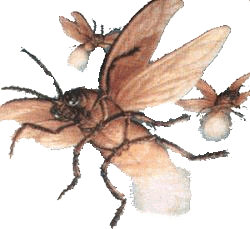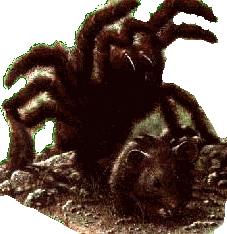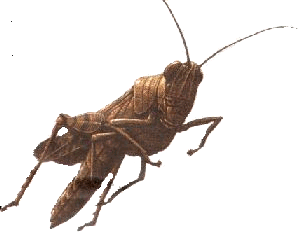
If you happen to teach biology in a bilingual class, you might want to something about
insects and spiders.
 If you want to get a more comprehensive understanding about insects, click on bugbios. Here you can explore the lives of ants, grasshoppers, crickets, bees and wasps. If you want to get a more comprehensive understanding about insects, click on bugbios. Here you can explore the lives of ants, grasshoppers, crickets, bees and wasps.
It's often easy to ignore them, as most of them are less than 6mm long.But more than a million species of them
have been discovered - which means they outnumber all other species of animals put together.
If you're not keen on spiders, here's some bad news - there are about 40,000 identified species of the amazing
arachnids (Spinnentiere). some are as small as pinheads, while others are twice the size of your hand.
Spiders developed from marine animals which took to the land about 400 million years ago. Many species have evolved over
time but others haven't at all. Here are a choice of the creepy-crawlies which almost everybody has at least heard of:
 Ladybirds usually have red, orange or yellow wing cases (Deckflügel). This brightly coloured protection warns predators to back
off as they taste horrible, When a ladybird flies, its wings emerge from under these hard cases.
Ladybirds usually have red, orange or yellow wing cases (Deckflügel). This brightly coloured protection warns predators to back
off as they taste horrible, When a ladybird flies, its wings emerge from under these hard cases.
 Do you start cowering when you see a bee or a wasp? You might be worrying unnecessarily. Only female wasps and bees have
stings, which are evolved from the egg-laying tube. Wasps sting to paralyse their prey or defend
themselves. A wasp's sting is a bit like a syringe so it can sting again and again. But a honeybee's sting
has a barbed tip which it can't extract, so some of its organs are torn out when it flies away. It only stings in self-defense and
when it does it dies.
Do you start cowering when you see a bee or a wasp? You might be worrying unnecessarily. Only female wasps and bees have
stings, which are evolved from the egg-laying tube. Wasps sting to paralyse their prey or defend
themselves. A wasp's sting is a bit like a syringe so it can sting again and again. But a honeybee's sting
has a barbed tip which it can't extract, so some of its organs are torn out when it flies away. It only stings in self-defense and
when it does it dies.
 Many insects, including locusts (Heuschrecken), mosquitoes and horseflies (Pferdebremse-like the one in the picture)
have compound eyes. These are made up of tiny lenses, called eyelets, packed together.
The more eyelets an insect has, the more clearly it can see. A worker ant which lives underground has only a few hundred lenses but a dragonfly (Libelle) can
have up to 30,000 lenses in each eye. The signal from the lenses are combined by the insect's brain to create a complete image.
Many insects, including locusts (Heuschrecken), mosquitoes and horseflies (Pferdebremse-like the one in the picture)
have compound eyes. These are made up of tiny lenses, called eyelets, packed together.
The more eyelets an insect has, the more clearly it can see. A worker ant which lives underground has only a few hundred lenses but a dragonfly (Libelle) can
have up to 30,000 lenses in each eye. The signal from the lenses are combined by the insect's brain to create a complete image.
Find out more about insects, spiders and many more creatures around the world here:

A third of all insects feed on other animals. Some actively hunt their prey, others like this praying mantis (Gottesanbeterin)
use camouflage to avoid being seen. Its plant-like body allows it to hide in vegetation. When a tasty
treat, such as a butterfly, is in reach, the mantis unfolds its powerful front legs and pounces. Sharp
spikes on the mantis's front legs means there is no chance of esacpe. And as if this wasn't bad enough for the butterfly, its
captor will often begin its meal whilst the poor prey is still struggling to escape.
 Like their relatives the spiders, the scorpions are arachnids. There are 1,500 species of scorpion - some
of which can kill with their poisonous sting in the tail. The most venomous is the Tunesian fat-tailed scorpion which
is responsible for 90% of deaths from scorpion stings in North Africa. Muscles in the scorpion's tail
squeeze poison down a tube into its prey. But these male and female scorpions (picture) are not fighting - they
are performing a mating dance.
Like their relatives the spiders, the scorpions are arachnids. There are 1,500 species of scorpion - some
of which can kill with their poisonous sting in the tail. The most venomous is the Tunesian fat-tailed scorpion which
is responsible for 90% of deaths from scorpion stings in North Africa. Muscles in the scorpion's tail
squeeze poison down a tube into its prey. But these male and female scorpions (picture) are not fighting - they
are performing a mating dance.
 When a male firefly (Leuchtkäfer) wants to attract a mate, he flashes his light and performs a special dance.
Female fireflies watch the display from near the ground and will respond if they like the look of him.
Each species of firefly has a different flashcode. Sometimes a hungry female may flash the pattern
of a different species and, when the male lands, eats him. Nasty!
When a male firefly (Leuchtkäfer) wants to attract a mate, he flashes his light and performs a special dance.
Female fireflies watch the display from near the ground and will respond if they like the look of him.
Each species of firefly has a different flashcode. Sometimes a hungry female may flash the pattern
of a different species and, when the male lands, eats him. Nasty!
 All spiders produce silk but not all species weave webs to catch their dinner. Spitting spiders squirt their prey with a glue-like liquid.
Grass spiders are incredibly fast and can out-run many other insects. And some jumping spiders which are
only 1.5cm long can leap on prey 20cm away. One of the most well-known spiders, the tarantula (picture), hunts to find its food.
Tarantulas don't see very well so they rely on vibrations to find mice, frogs, lizards and small birds
to snack on.
All spiders produce silk but not all species weave webs to catch their dinner. Spitting spiders squirt their prey with a glue-like liquid.
Grass spiders are incredibly fast and can out-run many other insects. And some jumping spiders which are
only 1.5cm long can leap on prey 20cm away. One of the most well-known spiders, the tarantula (picture), hunts to find its food.
Tarantulas don't see very well so they rely on vibrations to find mice, frogs, lizards and small birds
to snack on.
 If there was an Olympics for insects, grasshoppers would win the gold in the high jump. A grasshopper jumps to launch itself
into flight. It has spring-like mechanisms in its knees which increases the force of the jump. Muscles in the
hind legs flick backward to push it into the air. The muscle in a grasshopper's back leg is so
powerful it could lift a bag and a half of sugar.
If there was an Olympics for insects, grasshoppers would win the gold in the high jump. A grasshopper jumps to launch itself
into flight. It has spring-like mechanisms in its knees which increases the force of the jump. Muscles in the
hind legs flick backward to push it into the air. The muscle in a grasshopper's back leg is so
powerful it could lift a bag and a half of sugar.
 If you are also interested in birds, look here.
If you are also interested in birds, look here.
|


 Ladybirds usually have red, orange or yellow wing cases (Deckflügel). This brightly coloured protection warns predators to back
off as they taste horrible, When a ladybird flies, its wings emerge from under these hard cases.
Ladybirds usually have red, orange or yellow wing cases (Deckflügel). This brightly coloured protection warns predators to back
off as they taste horrible, When a ladybird flies, its wings emerge from under these hard cases. Do you start cowering when you see a bee or a wasp? You might be worrying unnecessarily. Only female wasps and bees have
stings, which are evolved from the egg-laying tube. Wasps sting to paralyse their prey or defend
themselves. A wasp's sting is a bit like a syringe so it can sting again and again. But a honeybee's sting
has a barbed tip which it can't extract, so some of its organs are torn out when it flies away. It only stings in self-defense and
when it does it dies.
Do you start cowering when you see a bee or a wasp? You might be worrying unnecessarily. Only female wasps and bees have
stings, which are evolved from the egg-laying tube. Wasps sting to paralyse their prey or defend
themselves. A wasp's sting is a bit like a syringe so it can sting again and again. But a honeybee's sting
has a barbed tip which it can't extract, so some of its organs are torn out when it flies away. It only stings in self-defense and
when it does it dies. Many insects, including locusts (Heuschrecken), mosquitoes and horseflies (Pferdebremse-like the one in the picture)
have compound eyes. These are made up of tiny lenses, called eyelets, packed together.
The more eyelets an insect has, the more clearly it can see. A worker ant which lives underground has only a few hundred lenses but a dragonfly (Libelle) can
have up to 30,000 lenses in each eye. The signal from the lenses are combined by the insect's brain to create a complete image.
Many insects, including locusts (Heuschrecken), mosquitoes and horseflies (Pferdebremse-like the one in the picture)
have compound eyes. These are made up of tiny lenses, called eyelets, packed together.
The more eyelets an insect has, the more clearly it can see. A worker ant which lives underground has only a few hundred lenses but a dragonfly (Libelle) can
have up to 30,000 lenses in each eye. The signal from the lenses are combined by the insect's brain to create a complete image. Like their relatives the spiders, the scorpions are arachnids. There are 1,500 species of scorpion - some
of which can kill with their poisonous sting in the tail. The most venomous is the Tunesian fat-tailed scorpion which
is responsible for 90% of deaths from scorpion stings in North Africa. Muscles in the scorpion's tail
squeeze poison down a tube into its prey. But these male and female scorpions (picture) are not fighting - they
are performing a mating dance.
Like their relatives the spiders, the scorpions are arachnids. There are 1,500 species of scorpion - some
of which can kill with their poisonous sting in the tail. The most venomous is the Tunesian fat-tailed scorpion which
is responsible for 90% of deaths from scorpion stings in North Africa. Muscles in the scorpion's tail
squeeze poison down a tube into its prey. But these male and female scorpions (picture) are not fighting - they
are performing a mating dance. When a male firefly (Leuchtkäfer) wants to attract a mate, he flashes his light and performs a special dance.
Female fireflies watch the display from near the ground and will respond if they like the look of him.
Each species of firefly has a different flashcode. Sometimes a hungry female may flash the pattern
of a different species and, when the male lands, eats him. Nasty!
When a male firefly (Leuchtkäfer) wants to attract a mate, he flashes his light and performs a special dance.
Female fireflies watch the display from near the ground and will respond if they like the look of him.
Each species of firefly has a different flashcode. Sometimes a hungry female may flash the pattern
of a different species and, when the male lands, eats him. Nasty! All spiders produce silk but not all species weave webs to catch their dinner. Spitting spiders squirt their prey with a glue-like liquid.
Grass spiders are incredibly fast and can out-run many other insects. And some jumping spiders which are
only 1.5cm long can leap on prey 20cm away. One of the most well-known spiders, the tarantula (picture), hunts to find its food.
Tarantulas don't see very well so they rely on vibrations to find mice, frogs, lizards and small birds
to snack on.
All spiders produce silk but not all species weave webs to catch their dinner. Spitting spiders squirt their prey with a glue-like liquid.
Grass spiders are incredibly fast and can out-run many other insects. And some jumping spiders which are
only 1.5cm long can leap on prey 20cm away. One of the most well-known spiders, the tarantula (picture), hunts to find its food.
Tarantulas don't see very well so they rely on vibrations to find mice, frogs, lizards and small birds
to snack on. If there was an Olympics for insects, grasshoppers would win the gold in the high jump. A grasshopper jumps to launch itself
into flight. It has spring-like mechanisms in its knees which increases the force of the jump. Muscles in the
hind legs flick backward to push it into the air. The muscle in a grasshopper's back leg is so
powerful it could lift a bag and a half of sugar.
If there was an Olympics for insects, grasshoppers would win the gold in the high jump. A grasshopper jumps to launch itself
into flight. It has spring-like mechanisms in its knees which increases the force of the jump. Muscles in the
hind legs flick backward to push it into the air. The muscle in a grasshopper's back leg is so
powerful it could lift a bag and a half of sugar.